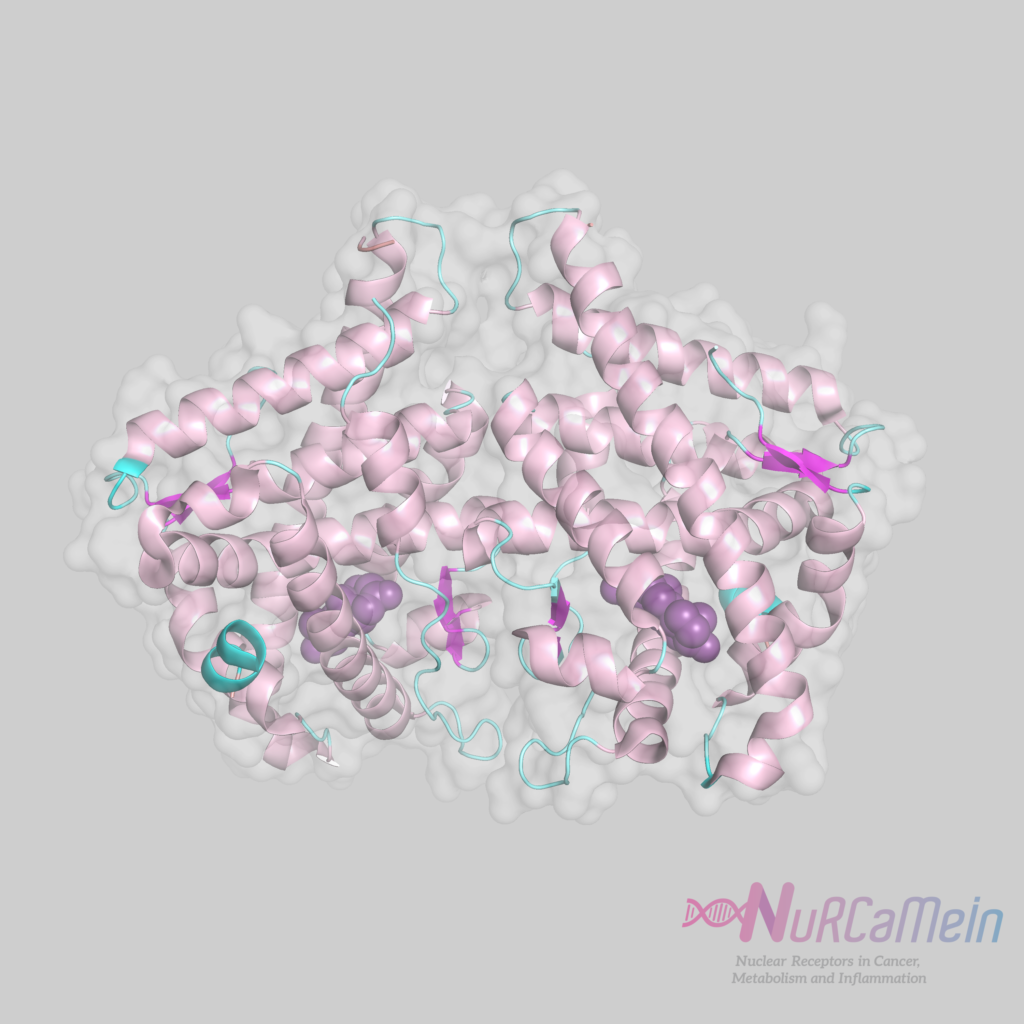AR (ANDROGEN RECEPTOR)
Androgen receptors (ARs) belong to the subfamily of steroid hormone receptors, together with estrogen receptors (ERs), glucocorticoid receptors (GRs), progesterone receptors (PRs) and mineralocorticoid receptors (MRs).
ARs are ligand-dependent transcription factors that control the expression of the genes involved in the development of the brain and the reproductive organs of males, mainly, and females.
Ligands
Androgens (steroid hormones) are the ligands of ARs. The androgen α-dihydrotestosterone (DHT), produced from testosterone, has the strongest affinity for ARs. The union of androgens activates ARs and triggers the development and differentiation of male reproductive organs.
Classification
Androgen receptors (ARs) are members of the NR3 subfamily of the big superfamily of nuclear receptors (NRs).
On the other hand, based on their affinity for the ligand and their mode of action, ARs are classified as endocrine receptors and type 1 receptors.
Structure and interactions
All the members of the family of nuclear receptors share a general multi-domain structure. Structure-wise, ARs are similar to other steroid hormone receptors (such as ERs or GRs), consisting of the following domains:
- A/B domain (or NTD / AF-1): This is an N-terminal region where coactivators bind. It can mediate transactivation of DNA (AF-1), being able to operate with or independently from the ligand.
- C domain (or DBD): This is a DNA binding region and it is highly conserved. It contains two zinc fingers that interact with the specific hormone-response elements (HRE in general, ARE in this case) and are involved in the dimerization of the receptor.
- D domain or hinge region: This region connects the C and E domains and gives flexibility to the receptor.
- E/F domain (or LBD / AF-2): This is a C-terminal ligand binding region which interacts with the coactivators and corepressors (ligand-dependant transactivation function AF-2).

AR structure
In the absence of a ligand (testosterone or DHT), ARs are found in the cytoplasm associated with proteins, such as heat shock proteins (HSP), that stabilize the receptors’ structure and prevent their activation. The binding of androgens produces a dissociation of these proteins, which activates ARs and induces the interaction between the N- and C-terminals. Then, the ARs enter the nucleus, undergo dimerization and interact with the androgen-response elements (AREs) of the DNA. When the AR dimers bind to DNA, the dimers form a complex with the co-regulatory proteins in the regions AF-1 and AF-2.
This is how ARs regulate the transcription of androgen-responsive genes, which are responsible for the expression of transcription factors (NKX3.1, FOXP1) and metabolic enzymes (CAMKK2) or the regulation of cell cycles (UBE2C, TACC2), among others.
Expression
The gene that codifies ARs is located in the X chromosome and it is particularly important in the maintenance of the homeostasis and the development of the prostate.
ARs are expressed at different levels in a wide variety of tissues: sweat glands, hair follicles, cardiac muscle, gastrointestinal smooth muscle cells, thyroid follicular cells and adrenal cortex cells.
In the male reproductive system, ARs are found mostly in some cells of the testicles (such as the Sertoli cells), the epididymis, the deferent ducts, the prostate and the germinal chambers. ARs are also found in smooth muscle cells, endothelial cells and fibroblasts of the testicles and the pathway of sperm.
Although germ cells require androgens for their survival and maturation, their development does not express ARs, which suggests that androgen hormones act through Sertoli cells and peritubular myoid cells of the testicles.
Main functions
While ARs are involved in several physiological functions, they play a key role in the expression of the male phenotype. Their main function is related to the normal development of the internal and external male organs.
ARs alterations can result in male infertility, prostate cancer or Androgen Insensitivity Syndrome (AIS), among other pathologies.
ARs in the NuRCaMeIn Network
- Institute of Biomedicine of the University of Barcelona (IBUB) | University of Barcelona
- Molecular structure of nuclear receptors | NuRCaMeIn
References
- Androgen receptor: structure, role in prostate cancer and drug discovery, MH Eileen Tan et al. | Acta Pharmacologica Sinica
- Androgen receptor roles in spermatogenesis and infertility, Laura O’Hara et al. | Best Practice & Research Clinical Endocrinology & Metabolism
- Role of Androgen Receptor in Prostate Cancer: A Review, Kazutoshi Fujita et al. | The World Journal of MEN’s HEALTH
- Cambios de expresión del receptor de andrógenos en relación con la subfertilidad del varón, Elia Dina Galo et al. | ASEBIR
- Mutaciones del gen del receptor de andrógenos en pacientes con adenocarcionoma de próstata clínicamente localizado, D. Sánchez Zalabardo et al. | Actas Urológicas Españolas
